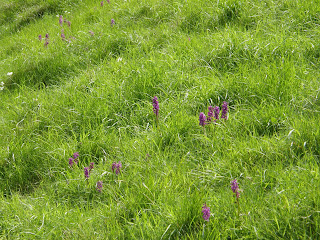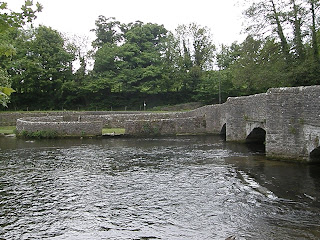
Thursday was such a lovely day that I decided to take advantage of it and go for a walk in Lathkill Dale. It's a national Nature Reserve and is famous for its wild flowers. The photo at the top is the early purple orchid. A lot of the photos will be improved by clicking on them.

It takes about 30 minutes to drive out to the village of Monyash where this walk begins. I parked in a layby just outside the village, crossed over and went through the gate into this gentle looking landscape.

I had to walk through this herd of young cows, they must be used to seeing hikers and apart from one or two curious looks they took no notice of me.

Right from the start the wild flowers were wonderful, this one is water avens which I've never seen growing wild before.

From a distance water avens isn't an especially eyecatching plant but the individual flowers are beautiful.

The blue flowers are Germander Speedwell, the pink ones are a type of vetch, the white one is Greater Stitchwort and the yellowy green flower is, I think, Lady's Bedstraw. I'm open to correction on this as I haven't seen it before and am by no means certain.

By this time the gentleness of the original scenery had changed and this is the path way ahead of me. As I walked on both sides of the dale rose steeply but there were still wildflowers everywhere. To my right there were hundreds of the beautiful purple orchids in the grass.It was impossible to take a photograph that really showed them up though unfortunately.

This was the best I could do.

There were several large patches of cowslips but they were virtually over, there were just the odd one or two still in flower, they must have been wonderful a couple of weeks ago.

This is pink campion, this is still quite common and grows on grassy banks on country lanes and in open bits of woodland too.

This shows the steep sides of the dale and the rocky outcrops of limestone. It looks so peaceful and rural doesn't it? Yet in the 18th and 19th centuries this was a busy industrial area with three corn mills working, men quarrying the limestone and the noise of the machinery used to mine the lead ore which lies beneath the surface. Leadmining was never very successful though as it proved impossible to drain the water from deep shafts. It's dangerous to leave the path in this area as there are still many hidden mineshafts.

This is a lovely flower but I have no idea what it is - any suggestions? I feel that I ought to know what it is but in spite of going through my wildflower books I haven't come up with any ideas. Apart from wildflowers there were also lots of bees and butterflies, I saw a couple of beautiful yellow Brimstones, some Peacocks and many pretty little Orangetips.

This is called Jacob's Ladder and I know it because the cultivated version grows in my garden. It is one of the rarest of Britain's wild flowers though and in spite of a notice saying that a particular fenced enclosure is full of them I saw only three or four plants flowering.

Lathkill Dale is very open and there is virtually no shade, this lamb had found one of the few cool spots on a hot day.

The halfway point on my circular walk and I am standing on a small bridge looking down on the River Lathkill which is more visible sometimes than others, in dry periods it has a habit of practically disappearing partly because the limestone is so porous and partly because the water drains away into an old leadmine drainage sough.

This photo shows why this area of Derbyshire is known as the White Peak, the soil here is thin and poor and it's an area of caves and dry river valleys. It's a favourite area for potholers and I can only say rather them than me! The recently discovered cave called Titan is in the White Peak and is the largest known cave in the UK. It is not on my list of places I want to visit!! The Dark Peak is also limestone but is covered with a layer of millstone grit which makes it badly drained and this is the part which is the peat moorland.

After crossing the bridge and following the path upwards and round a bend I found to my surprise that I was walking through woodland and eventually I came to this rather magical, mysterious place with steps cut into the rock climbing upwards to a small cave.

The track eventually led to a farm and as I went through the farmyard I saw what must be about the most luxurious pigsty I've ever seen.

The slits in the wall had a sloping piece of stone on the lower half and that must be where the pigswill was poured in to the grateful recipients on the other side.

Here is the only occupant of this palace among pigsties - you will need to click to see her as I didn't feel I should start scrambling about on the stonework to get a better picture.

Beyond the farmyard I found this lovely old-fashioned signpost, so much nicer than the horrid modern metal ones and just as readable and effective.

Further on still I came across this rather splendid gentleman - there was a stone wall between him and me but to be honest he looked rather a sweetie, some of the sheep looked fiercer than he did.

The last lap walking along the top of the dale and looking down on the area where I'd walked earlier in the day. This is modern agricultural pastureland and the lack of wildflowers was really noticeable. Nature Reserves like Lathkill Dale are the last bastions of the once rich diversity of the English countryside.

















